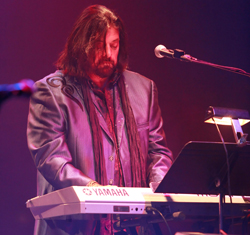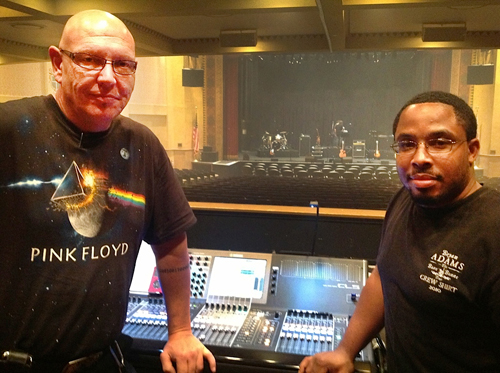
During the U.S. run, Frey mixed on six different consoles – a Midas Heritage 3000 analog, as well as Yamaha CL5 and PM5D, Avid VENUE Profile and SC48, and DiGiCo SD8 digital models.
“It was my first time on one of DiGiCo’s newer consoles,” he states. “I’ve mixed on the D5 so I’m familiar with the platform, but it’s a different control surface, so I downloaded the offline editor in advance, put together an I/O template and emailed it to the production manager to load onto the desk.”
He leans toward the Avid VENUE platform. “They provide an immense variety of plug-ins, and although I generally don’t use a lot of them, the ones I do use just aren’t available in other platforms unless you have a Waves bundle,” Frey says. “I really like the Universal Audio LA-2A for bass. Other than that and multi-layered drum compression, the effects I use for this group is very basic – just two reverbs, one for the drums and one for everything else.”
The latter is largely used for vocals, but Frey also employs it for solos “to keep everything in the same space, sonically.
“I also apply a delay for vocals and sax solos, and a pitch effect for vocal thickening, but it’s very subtle,” he continues. “Everybody sings, Alan, Alastair (Greene, the electric guitar player) and Todd (Cooper, the sax player) double on lead vocals for a few numbers, and with seven vocalists and seven-part harmonies, the vocals are big already.”

Frey usually tours with his own nearfield monitoring package for front of house – a pair of EAW MicroWedge MW10s driven by an amplifier and an EAW UX3600 3-in/6-out digital processor. This time out, however, he kept it simple by using headphones, a matter of expediency.
Favoring The Overhead
The tour carried a straightforward microphone package, including models from Audio-Technica, which Parsons endorses. A-T ATM350s cardioid condensers were clipped to the drum toms, with AT4033 large-diaphragm condensers utilized with guitarist Greene’s Marshall cabinet.
“The ATM350s travel with us everywhere,” Frey details. “I like using condensers on rack and floor toms. They tend to have a flat response and bring out the actual sound of the drums and drummer, and our drummer, Danny Thompson, is very dynamic. We can have a 25 to 30 dB range in level on the drums, which means I have to be very careful with gating because I don’t want to miss a note.”
To fill out the drum package, Frey requests a Shure Beta 52 for kick and SM57 for snare based on their wide availability and consistency, as well as the fact that they can take substantial abuse and still perform well.

“I’ve never really felt the necessity to have more than one microphone on a snare drum,” Parsons states. “If there’s not enough top-end snap, I prefer to add EQ rather than mic the snare bottom. I think using EQ is more natural and, after all, when you’re listening to a snare in a room you don’t have your head underneath it, do you? If you want it to sound like drums, you’ve got to favor the overheads and tops of the drums.”
Similarly, he wasn’t convinced that two mics on the kick would make a “night and day” difference, given the ample low-end support offered by the subwoofers included with the systems encountered on the tour. Shure SM81s captured hi-hat, and Frey chose to carry a Shure VP88 stereo condenser for overhead to capture imaging, which is also helpful to monitor engineer Phil Dunn’s in-ear monitor mixes.
All vocalists were supplied with Shure SM58 microphones, with Cooper (again, the band’s saxophonist) given his SM58 wirelesslesly. Frey also used an SM58 for Parsons’ vocoder, patched through the unit’s XLR out. Most direct (DI) boxes for Manny Foccarazzo’s keyboards as well as numerous players’ acoustic guitars were supplied by the house or rented. But Frey carried a Radial JDI specifically for Guy Erez’s bass, and he also deployed a pair of Optogate PB-05 automatic mic gates on the vocoder and Erez’s vocal.
